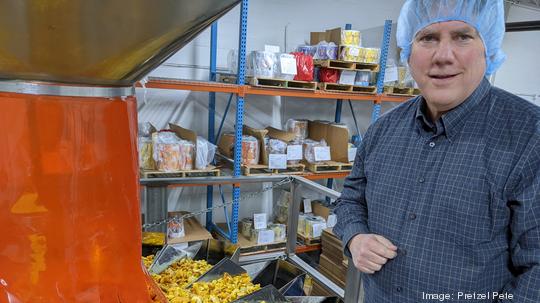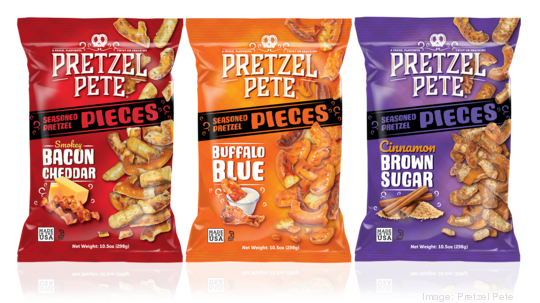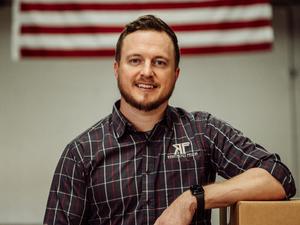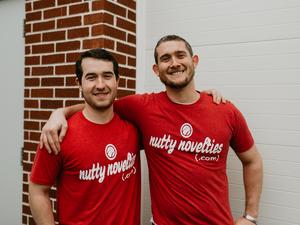
The revelation hit Karl Brown on a visit to London. Nowhere in one of the world’s most sophisticated cities could he find hard pretzels. So he decided to change that.
Then a banker at CoreStates Bank N.A. (now part of Wells Fargo, after multiple acquisitions), Brown was stationed in Germany for a year and spent time traveling around Europe. It was during this time in the 1990s he began experiencing the lack of certain snack foods abroad. When speaking with a fellow banker and friend also stationed in Europe, they both shared their frustration and agreed they could bring the American pretzel to Europe.
That move set in motion two different businesses. The pair embarked on creating SB Global Foods, which exports American snack foods around the globe. Brown’s business partner ultimately decided to remain in banking while Brown pressed ahead, taking it on full-time. But like the move to launch SB Global Foods, Brown wanted to control his own destiny, something that could change at a moment’s notice if brands decided not to work with him, so he also started his own product lines.
Brown saw certain segments proliferate, specifically marshmallows and pretzels, and went on to create Rocky Mountain Marshmallows and eventually Pretzel Pete. Ultimately, SB Global Foods and Rocky Mountain Marshmallows were folded into a portfolio owned by Illinois-based Doūmak, which also owns Campfire Marshmallows. There, SB Global Foods’ team operates as an exporting arm for the company, selling in around 75 countries.
For Brown, who grew up in Lancaster, pretzels remained important. Finding that non-Americans didn’t have a taste for plain pretzels, he focused on the seasoned segment. In 2012, he formally spun that business out under the Pretzel Pete moniker.
Brown self-funded both businesses and credits his banking background with helping him navigate that process. “It provided liquidity at a lot of different stages,” he said.
In the decade since, much has changed. Brown started with a co-packer, but in 2016, wanting to take full control of operations he decided to build out his own manufacturing. That facility, which employs over 30, is located in Hatboro and churns out millions of pretzels each year.
Establishing his own manufacturing has allowed the business “to grow substantially,” Brown said, noting that since 2016 business has quadrupled. It shows no signs of slowing. Business was up 45% in the first four months of 2022 compared with the same time frame the year prior. While that certainly is a boon, Brown said due to supply chain it is at times putting stress on operations.
A “value-added manufacturer,” the company seasons and packages pretzels not just for Pretzel Pete, but for other companies by way of co-packing. They also do bulk production and have counted Walmart, Trader Joe’s and Sam’s Club among their clients, generally for snack mixes where theirs isn’t the only product. Brown estimated that 35% to 40% of business is for the Pretzel Pete brand, with the rest coming from bulk and co-packing business.
Harkening back to his earliest days in the business, export remains a significant piece of the puzzle. “We still have a very disproportionately high percentage of our sales overseas than most other snack companies, or most other U.S. companies, period,” he said, estimating that roughly 50% of sales are domestic and 50% international.
Like sales diversification, product diversification has been important, too. Pretzel Pete launched with nugget-shaped pretzels but has since expanded into twists, pieces and pretzel medleys, with a mix of different shapes.

The company launched with a honey mustard flavor, which remains a top seller, and has dramatically expanded its offerings to include flavors like buffalo blue, cinnamon brown sugar, cheese pizza, and garlic parmesan. In 2021, Brown also launched a seasonal initiative where the company rolls out limited edition flavors – like margarita mini twists – every few months.
In total, products are in between 800 and 1,200 stores in the U.S., Brown estimated.
Sales are predominately wholesale, though they do have a loyal segment of consumers that buy direct since the brand and its manufacturing facility are free from common allergens like peanuts, tree nuts and sesames.
While the company isn’t aggressively marketing its products, it is quietly being placed in network and premium subscription shows. Working with a third party, Pretzel Pete has had passive product placement in shows like “The Big Bang Theory,” “Grace and Frankie,” and “Silicon Valley,” among others.
Pretzel Pete has also worked with airlines like American and United where its products have been placed in premium options like first class lounges and specialty food boxes. Like with the shows, Brown said it’s about “creating impressions.”
If growth is any indicator, Brown has certainly been doing that and he won’t be stopping any time soon.
What is it about American foods that draws international consumers?
There is a high level of appreciation … of American-made products. In almost every case, American products are significantly more expensive than other products in the market, whether locally made or brought in from other parts of the world. However, they carry a certain level of prestige, and also for many consumers who can afford it a level of assurance about the food safety standards.
Where are the exports concentrated?
It's where there's high levels of disposable income and high levels of population. Our biggest markets historically have been Germany, the United Kingdom, Japan, and Saudi Arabia has been a very good market. China was a terrific market for us up until we got into the trade wars. But basically all the major first world economies are our big markets for American products.
What are your goals going forward?
We certainly want to continue to grow. I think we have an immediate challenge right now on supply chain, with the growth in ingredients. And also there's been some changes in the pretzel industry itself with capacity. Some capacity has gone out of the segment, so that has created additional supply chain issues. I'm more focused right now on trying to streamline and improve our supply chain…. My focus has to be on how do we produce it faster and lay a foundation so that we are going to be a cost competitive, efficient supplier on an ongoing basis. Reestablishing and reinventing that foundation from a supply chain standpoint is the most important thing, because that's on what the future growth will be predicated. There's huge growth opportunities. As far as where we're excited, a lot of it's overseas.







